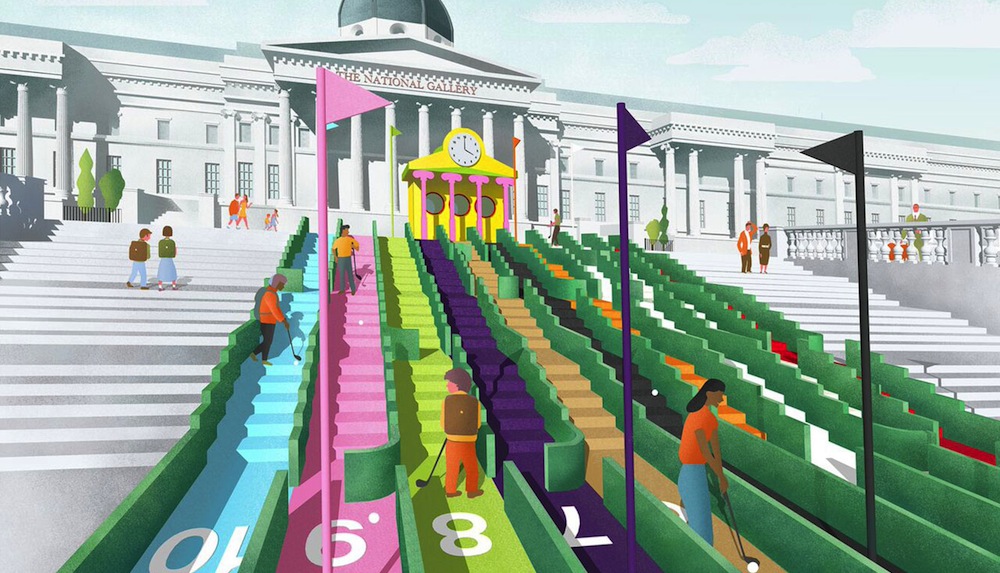The London Design Festival launched a crowdfunding campaign to raise money for one of the craziest mini-golf courses ever made.
The plan is to turn London’s Trafalgar Square into a colorful course this September. Notable designers, including Tom Dixon, Mark Wallinger, and the late Zaha Hadid, each get to create a hole of their own.
Eight holes have been designed for the mini-golf (known in the UK as "crazy golf") course, and they all feature much more than a windmill and a turf incline. Dixon’s hole integrates pneumatic tubes; players must navigate Wallinger’s circular maze; and Hadid designed a curvy, dual-level hole that traces the shadow of the square’s Nelson’s Column. The entries are bright, creative, and, to many putt-putt golfers across the universe, at least a quadruple bogey.
Paul Smith is the project’s visionary. The architect has held other events at Trafalgar Square over the years, including life-size chess and a robot show. Smith’s hole calls for a set of 10 multicolored stairways. The other designers who took part in the project are Camille Walala, Atelier Bow-Wow, HAT Projects, NEON, and Ordinary Architecture, the latter of which envisioned a hole where a player hits their ball into a large pigeon and watches it roll through its digestive tracks.
The project’s goal is to amuse both adults and children, and teach the public about the future of design.
The course “will attract a wide, public audience, and inspire the next generation of creatives,” as its Kickstarter puts it. “Thousands will be able to play the course, and millions more will watch and enjoy this experience, both in the square and through media.”
A little more than $5,000 has been raised thus far. There are still 42 days left to reach the $172,862 goal.
Related Stories
| Nov 8, 2013
Oversized healthcare: How did we get here and how do we right-size?
Healthcare facilities, especially our nation's hospitals, have steadily become larger over the past couple of decades. The growth has occurred despite stabilization, and in some markets, a decline in inpatient utilization.
| Nov 8, 2013
Can Big Data help building owners slash op-ex budgets?
Real estate services giant Jones Lang LaSalle set out to answer these questions when it partnered with Pacific Controls to develop IntelliCommand, a 24/7 real-time remote monitoring and control service for its commercial real estate owner clients.
| Nov 8, 2013
S+T buildings embrace 'no excuses' approach to green labs
Some science-design experts once believed high levels of sustainability would be possible only for low-intensity labs in temperate zones. But recent projects prove otherwise.
| Nov 8, 2013
Net-zero bellwether demonstrates extreme green, multifamily style
The 10-unit zHome in Issaquah Highlands, Wash., is the nation’s first net-zero multifamily project, as certified this year by the International Living Future Institute.
| Nov 8, 2013
Walkable solar pavement debuts at George Washington University
George Washington University worked with supplier Onyx Solar to design and install 100 sf of walkable solar pavement at its Virginia Science and Technology Campus in Ashburn, Va.
| Nov 6, 2013
PECI tests New Buildings Institute’s plug load energy use metrics at HQ
Earlier this year, PECI used the NBI metrics to assess plug load energy use at PECI headquarters in downtown Portland, Ore. The study, which informed an energy-saving campaign, resulted in an 18 percent kWh reduction of PECI’s plug load.
| Nov 5, 2013
Net-zero movement gaining traction in U.S. schools market
As more net-zero energy schools come online, school officials are asking: Is NZE a more logical approach for school districts than holistic green buildings?
| Nov 5, 2013
New IECC provision tightens historic building exemption
The International Energy Conservation Code has been revised to eliminate what has been seen as a blanket exemption for historic buildings.
| Nov 5, 2013
Living Building Challenge clarifies net-zero definitions and standards
The Living Building Challenge has released the Net Zero Energy Building Certification to provide clearer definitions regarding what net zero really means and how it is to be achieved.
| Nov 5, 2013
Oakland University’s Human Health Building first LEED Platinum university building in Michigan [slideshow]
Built on the former site of a parking lot and an untended natural wetland, the 160,260-sf, five-story, terra cotta-clad building features some of the industry’s most innovative, energy-efficient building systems and advanced sustainable design features.

















